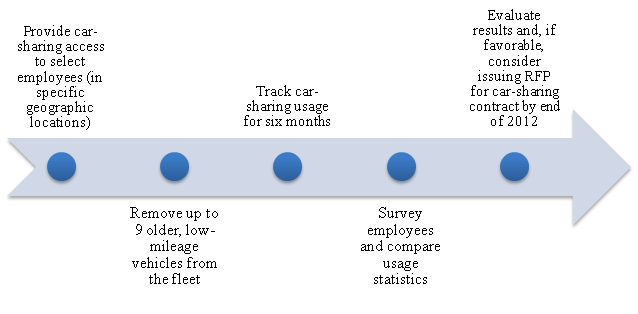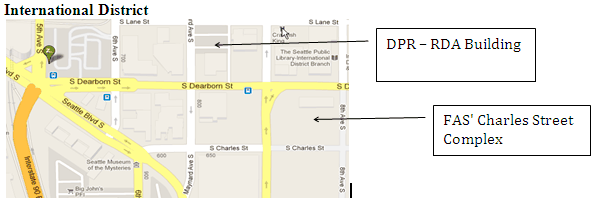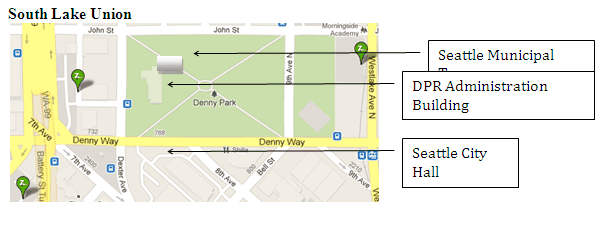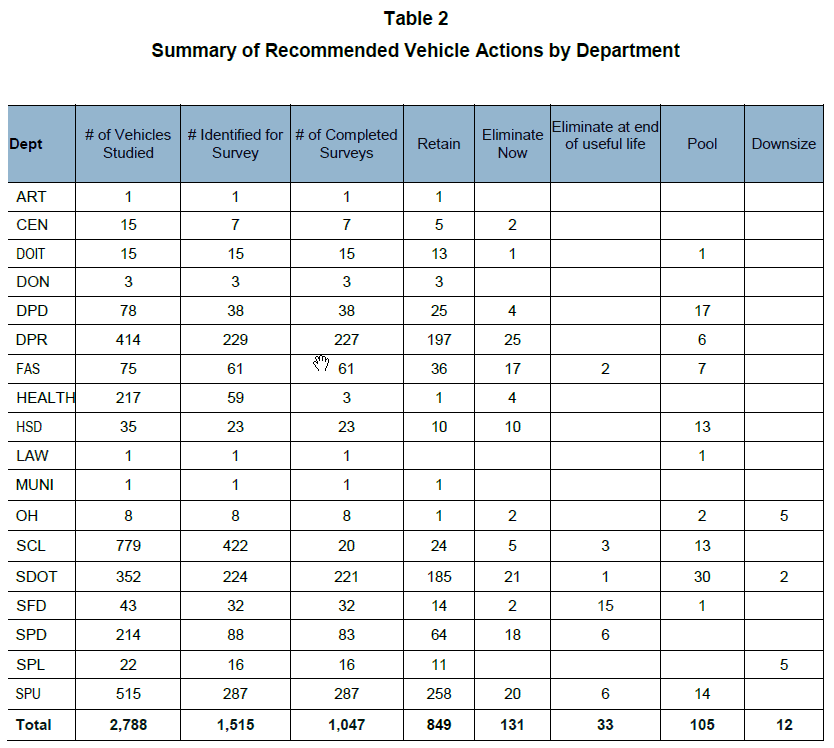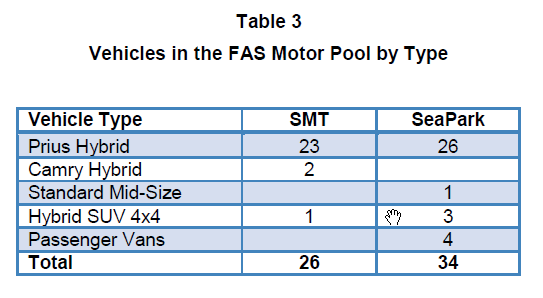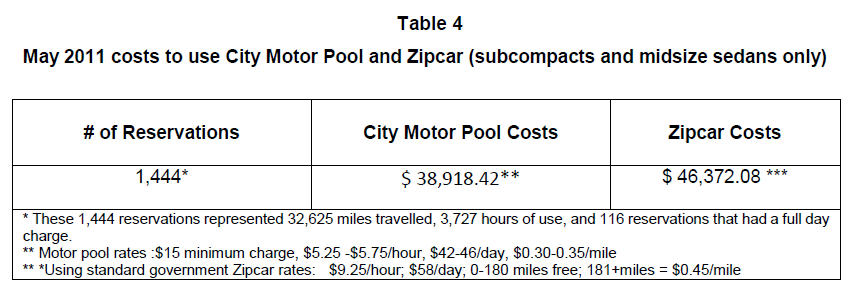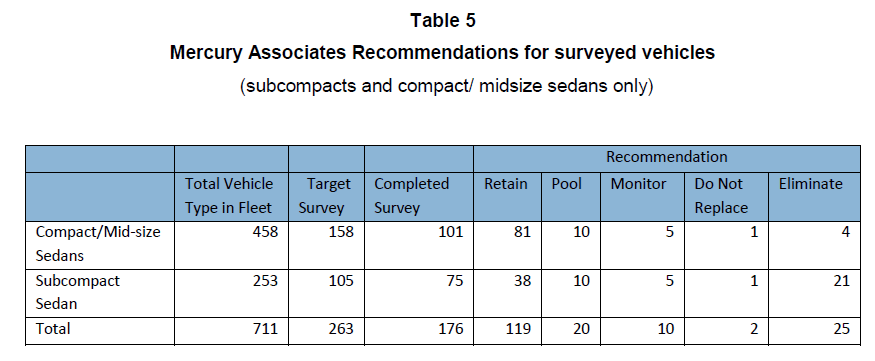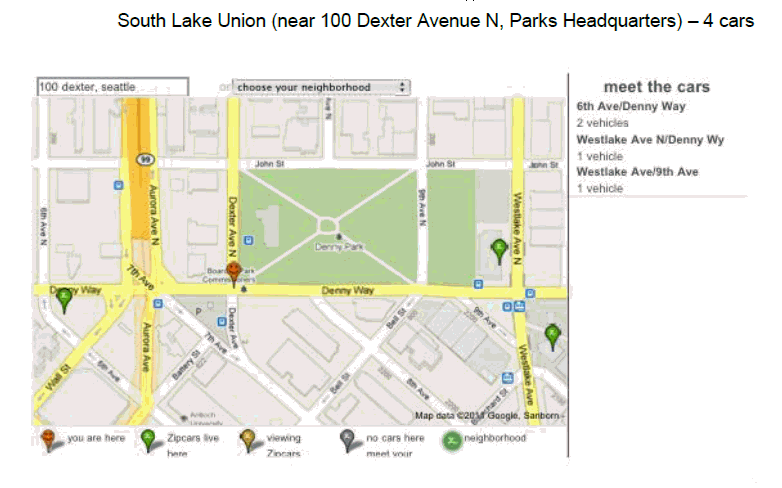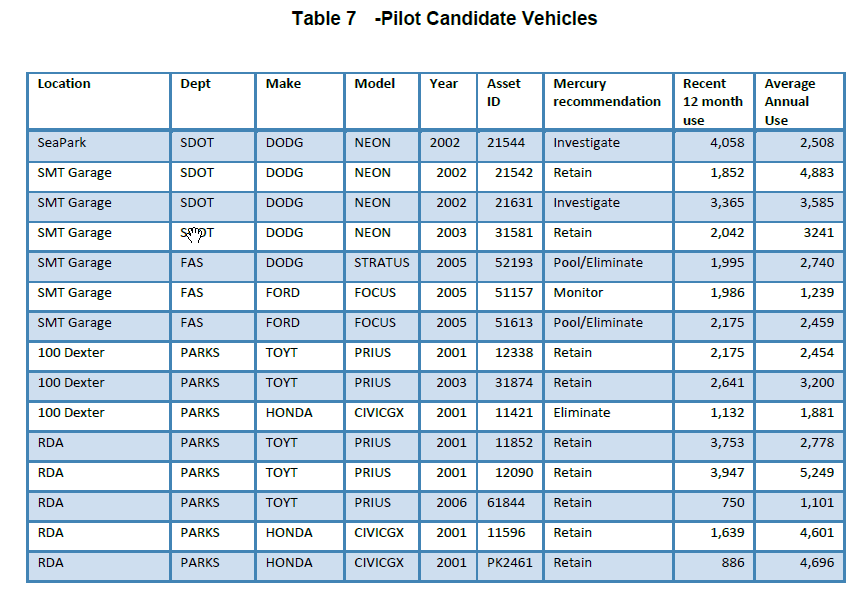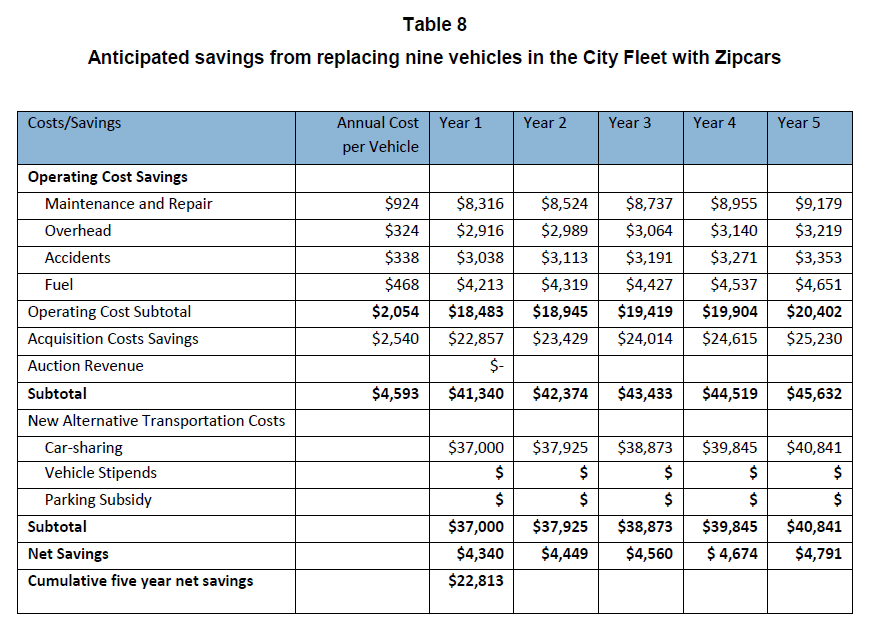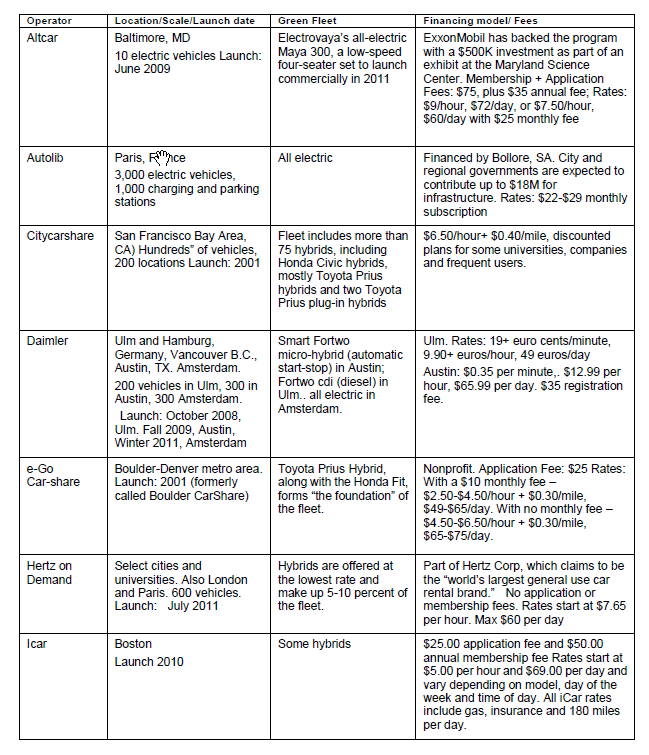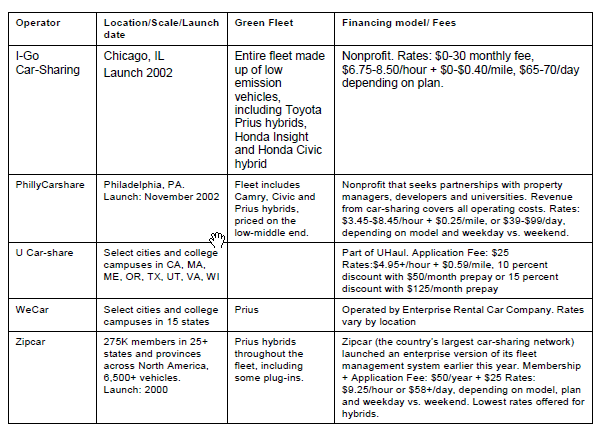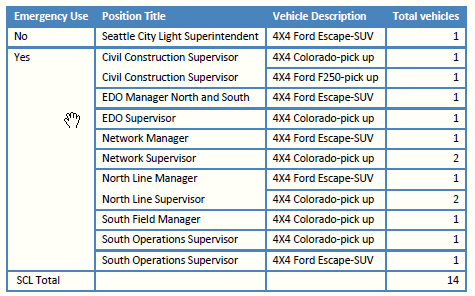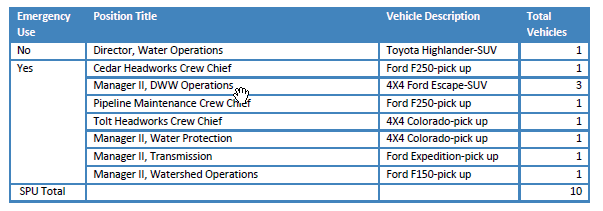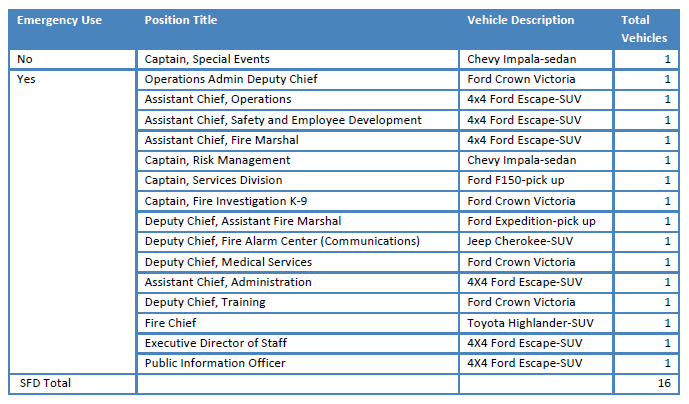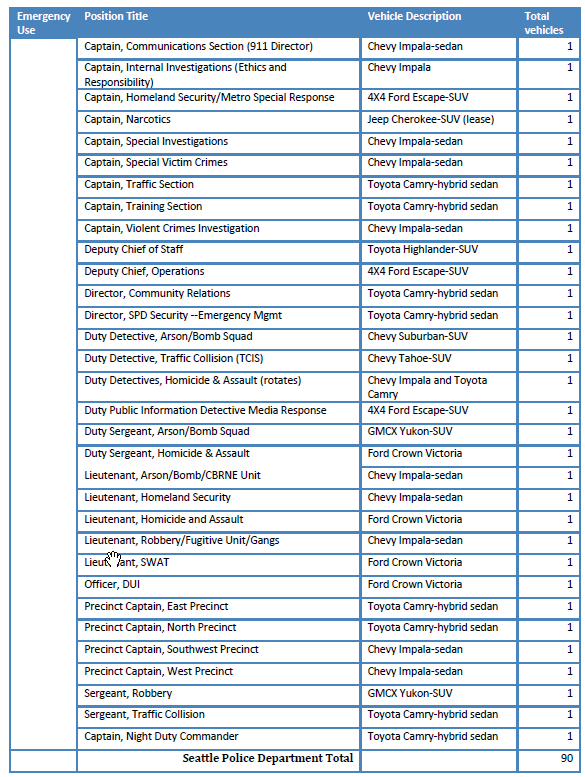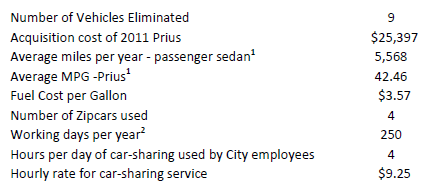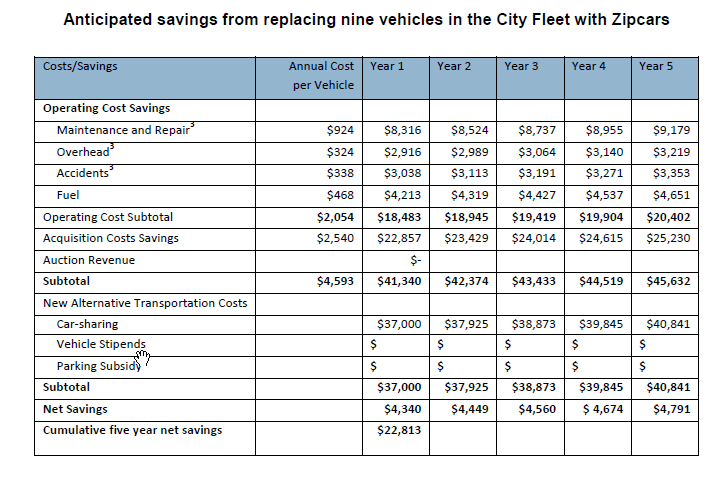Seattle Comptroller/Clerk Files Index
Information modified on July 25, 2013; retrieved on May 21, 2025 9:58 PM
Clerk File 311762
Title | |
|---|---|
| Finance and Administrative Services (FAS) Response to 2011 - 2012 Statement of Legislative Intent No. 45-1-A-2: FAS - Vehicle fleet reduction through car-sharing feasibility report. | |
Description and Background | |
|---|---|
| Current Status: | Filed |
| Index Terms: | FLEETS-AND-FACILITIES-DEPARTMENT, AUTOMOBILES, MOTOR-VEHICLES, CONSERVATION |
| Notes: | This Clerk File contains both the initial SLI response dated September 15, 2011, and a follow-up dated July 17, 2013. |
| References: | Related: Resolution 31269, Ordinance 123442, Clerk File 311072 |
Legislative History | |
|---|---|
| Date Filed with Clerk: | September 16, 2011 |
| PDF Copy: | Clerk File 311762 |
Text | |||||||||||||||||||||||||||||||||||||||||
|---|---|---|---|---|---|---|---|---|---|---|---|---|---|---|---|---|---|---|---|---|---|---|---|---|---|---|---|---|---|---|---|---|---|---|---|---|---|---|---|---|---|
|
M E M O R A N D U M DATE: July 17, 2013 TO: Honorable Tim Burgess, Chair Government Performance and Finance Committee VIA: Beth Goldberg, Director City Budget Office FROM: Fred Podesta, Director Finance and Administrative Services SUBJECT: Car-sharing Feasibility Recommendations Follow-up to 2011 SLI 45-1-A-2 I am pleased to provide the results of the Car-Sharing Feasibility Study, which is a follow-up analysis that was recommended in the Executive's response to the Council's 2011 Statement of Legislative Intent 45-1-A-2. If you have any questions or would like a briefing on this matter, don't hesitate to call me at 206/386-0041. cc: Jaline Quinto, Mayor's Office Jennifer Devore, CBO Dave Seavey, FAS Chris Wiley, FAS Lisa Peyer, FAS Attachment 1: FAS Vehicle Reduction through Car-Sharing Feasibility Study (Response to SLI 45-1-A-2) Department of Finance and Administrative Services Commercial Car-Sharing Pilot Project (Follow up to 2011 SLI 45-1-A-2) Summary As a follow up to the Seattle City Council SLI 45-1-A-2 requesting the Department of Finance and Administrative Services (FAS) to report on the feasibility of reducing a portion of Seattle's vehicle fleet by contracting with a carsharing company, FAS conducted a 6-month car-sharing pilot in 2012. The pilot worked with 80 City of Seattle employees at various locations in the City and used Zipcar as the carsharing provider. Due to the findings of the pilot, FAS recommends that the City should contract with a commercial car-sharing service to expand the transportation options available to employees who work outside the downtown core. Background In considering the 2011-2012 budget, the Seattle City Council adopted SLI 45-1-A-2 (see Attachment 1 for SLI response) that requested FAS to report on the feasibility of reducing a portion of Seattle's vehicle fleet by contracting with a carsharing company. FAS' report to the City Council on December 6, 2011 was used by the Council to decide that a pilot project was needed to determine whether it was feasible to contract with a carsharing company and accomplish the City's goals of availability, ease-of-access and cost-effectiveness. FAS proposed a five-step car-sharing pilot project as follows:
FAS began developing the commercial car-sharing pilot project in early 2012 by selecting Zipcar, Inc. to be the service provider. At the time, Zipcar was the only market-ready service with vehicles on the ground and in locations accessible by City staff. The pilot project was launched on May 1, 2012. The Project Pilot Project Parameters
The car-sharing pilot project focused on evaluating the following three key areas to determine whether car-sharing might be a useful transportation tool for City staff to use while conducting City business: 1. Availability -cars must be available nearby when employees need them. 2. Ease of use -employees must be able to make reservations quickly and easily, and comply with program rules without incurring excessive penalties. 3. Cost-effectiveness -the cost of the service must be cheaper to use than a City fleet alternative (i.e. department-owned or motor pool vehicle). Implementation The project targeted three City departments: FAS, DPR and SDOT. All these departments have operations in both the downtown core and in satellite locations near the International District and South Lake Union. The locations of the parked Zipcar vehicles were convenient because of their proximity to City offices located outside of the downtown core as shown in the maps below.
Results
More than 120 City staff were invited to participate in the pilot project, with 80 signing up to use Zipcar for conducting City business. Subsequently, a pilot project participant survey was sent out to gauge participants' experience when using the car-sharing service. This survey was used to evaluate two of the key factors mentioned previously: 1) the availability of the vehicles, and 2) the program's ease-ofuse. The issue of cost-effectiveness is addressed separately in this report. The survey indicated the following about those employees who took advantage of the pilot program: * 45 of the respondents signed-up for Zipcar through the City's business membership; * 21 of the respondents who obtained Zipcar through the City's business membership hadn't yet driven a Zipcar; and * Six respondents obtained their own personal membership for personal (non-city business) use. The 78 survey responses that were received yielded the following results: Availability * Only one survey respondent indicated that a car was unavailable at the start of the reservation. Ease-of-Use * 88% of respondents found the reservation system was easy or very easy to use; * 88% of respondents indicated the Zipcar vehicle was easy or very easy to find at the beginning of a reservation and it was easy or very easy to return the vehicle at the end of the reservation; * 21% of respondents had to report issues (low fuel, damage, etc.) however, all respondents agreed the Zipcar system was easy or very easy to use when dealing with reported issues. Overall, based on the results of the survey, Zipcar was shown to provide an easy-to-use system with vehicles available when needed. Cost-Effectiveness DPR's experience in the pilot most closely reflected what we would expect from an ongoing implementation of commercial car-sharing in that they temporarily withdrew vehicles from their fleet, which FAS and SDOT did not do. DPR had a much higher participation in the pilot with 159 trips. SDOT had 12 trips, and FAS had 4 trips. There was nothing in the FAS and SDOT cost analysis that would argue against the conclusion drawn from the DPR data. The chart below provides cost information for 159 trips made by DPR compared to what those trips would have cost using the City's e-Go motor pool. An apples-to-apples cost comparison is complicated by the different pricing structures for Zipcar and e-Go. This issue is most clearly illustrated by the differences in the triggering mechanisms and prices for special fees, such as late fees, no-shows, accident damage fees, reservation changes or cancellations, and insufficient fuel upon return of the vehicle. Special fees averaged approximately 7.4% of the total charges for Zipcar, whereas comparable fees for e-Go average 10% of the total charges. As shown in the table, the basic costs associated with renting e-Go motor pool vehicles are lower than Zipcar. Nevertheless, a critical is that the City would incur additional administrative and operational expenses to make motor pool vehicles available at satellite locations that are not captured in the table below. Motor pool services are not currently available outside of the downtown core.
* Assumptions: Used the cost methodology for each (Zipcar charges an hourly rate based on the length of the reservation; e-Go charges an hourly rate based on the actual minutes used); A rate of $11.43 per hour was used for Zipcar ($9.75 per hour plus 17.2% tax); A rate of $12.50 per hour was used for e-Go; There are no on-street parking charges for the City's e-Go motorpool vehicles. To further evaluate cost-effectiveness, staff compared the cost of using Zipcar with costs that would have been incurred using the four DPR vehicles that were reduced during the pilot project.
* Note: this is the lease rate cost and does not include fuel and accident costs, which are paid directly by DPR. Based on both sets of cost comparison data above, using a commercial car-sharing service can be cost-competitive as compared to the City's e-Go motor pool or leasing vehicles from FMD. Recommendation The pilot project indicates the City of Seattle could benefit from using a commercial car-sharing service as another transportation option for its employees who use passenger vehicles to conduct City business. This is especially true for City departments serving residents at satellite offices outside of the downtown core. A commercial car-sharing option could help to reduce some costs and provide another alternative to help City employees meet their business-related transportation needs. Since the pilot began eleven months ago, several new carsharing companies have come to the Puget Sound region, providing more transportation options than were considered for the pilot. Therefore, FAS recommends going out with a Request for Proposals or using some other contracting mechanism (e.g. Opportunity to Bid, "Piggybacking" on other municipal contracts, etc.) to continue and broaden the use of commercial car-sharing services for City offices located outside of the downtown core. Honorable Tim Burgess/ Fred Podesta Commercial Car-Sharing Pilot Project Follow-up July 17, 2013 City of Seattle Department of Finance and Administrative Services Fred Podesta, Director Phone (206) 386-0041 700 Fifth Avenue, 52nd Floor Fax (206)684-7898 P.O. Box 94689 TDD (206) 615-0476 Seattle, Washington 98124-4689 fred.podesta@seattle.gov * * * * * * * * * * * * * * * * * * * * * * * * City of Seattle Seattle City Council MEMORANDUM Date: September 15, 2011 To: Monica Martinez Simmons, City Clerk HARD COPY: City Hall, Third Floor, Main Reception ELECTRONIC COPY: clerkfiling@seattle.gov From: Susana Serna, Council Central Staff (Ketil Freeman, Staff Analyst) Re: Request to Create Clerk File -Response to 20112012 Council Statement of Legislative Intent Title of Clerk File: Finance and Administrative Services (FAS) Response to 2011 -2012 Statement of Legislative Intent (SLI) No. 45-1-A-2: FAS -Vehicle fleet reduction through car-sharing feasibility report. Please cross-reference: Resolution No. 31269 (2011-2012 SLI Adoption Resolution) Ordinance No. 123442 (2011-2012 Budget Adoption Ordinance) Clerk File No. 311072 (City Council Changes to the 2011-2012 Proposed Budget and the 2011-2016 Proposed Capital Improvement Program) Please create a Clerk File for the FAS response, and related documents to 2011-2012 Council SLI No. 45-1-A-2. I am attaching hard and electronic copies of all materials related to this SLI. Clerk File Table of Contents:
City of Seattle FAS Vehicle Reduction through Car-Sharing Feasibility Study SLI 45-1-A-2 Response September 15, 2011 SLI Overview In the 2011 budget process, the Seattle City Council adopted SLI 45-1-A-2 that requested that the Department of Finance and Administrative Services (FAS) report on the feasibility of reducing a portion of Seattle's vehicle fleet by contracting with a car-sharing company. The Council requested that the feasibility report, which is to be used to determine whether to establish a pilot project, include the following: * Cost/Savings Estimate: The report should identify which fleet vehicles are best suited for replacement with vehicles in a car-sharing program and estimate the capital and operating cost savings, if any, of implementing a program. * Barriers: The report should identify barriers to implementing a program including, but not limited to, contractual arrangements with vendors, adopted City policies and regulations, market conditions for potential car-share partners, and practicality for City-users. * Reduced Demand for Take-home Vehicle Program: The report should include an analysis of whether implementation of a car-share program would reduce the need for take-home vehicles and whether any associated changes should be made to criteria for take-home vehicles set out in Seattle Municipal Code Section 3.126.010. Additionally, and notwithstanding the feasibility of substituting car-share vehicles for take-home vehicles, FAS should analyze the feasibility and potential cost-savings associated with reimbursing employees who are assigned take-home vehicles for the use of their personal vehicles for trips that otherwise would be made using an assigned take-home vehicle. * Trip Reduction and VMT Reduction: The report should propose a set of metrics that could be applied to a pilot to determine whether implementation results in reduced demand for vehicles, reduced vehicle miles traveled, and reduced emissions associated with City-trips. Executive Summary The Department of Finance and Administrative Services (FAS) has embarked on a comprehensive program to streamline the City's fleet. FAS contracted with Mercury Associates in 2010 to assist in this effort. Mercury Associates studied more than 1,500 low mileage/low use vehicles and equipment in the fleet, and identified more than 164 vehicles for elimination either immediately or at the end of their useful lives and 105 vehicles for re-assignment to a centralized motor pool. FAS is working actively with departments to implement these recommendations, and yet, there are still opportunities to reduce the fleet further, particularly if employees are given alternatives to meet their work-related transportation needs. Examples of these alternatives include: * Taxi service for short trips in the downtown area; * Shuttle service from City offices on the periphery of downtown; * Web-based rideshare service; * Employee reimbursement for use of a personal vehicle; and * Car-sharing with a commercial service. This SLI response explores whether contracting with a private car-sharing company would allow the City to save additional money and reduce vehicle miles traveled compared to using cars assigned to individual departments or to FAS' motor pool. To study whether car-sharing provides an economically viable and operationally efficient mode of transportation for City employees, FAS proposes to conduct a six-month pilot with Zipcar, the only car-share provider currently operating in Seattle. Zipcar has multiple car-share vehicles already located near City offices and work sites in the Central Business District and surrounding neighborhoods. During this pilot, the City would select at least nine low mileage passenger fleet vehicles that average less than 6,000 miles per year and are currently housed at 100 Dexter, 800 Maynard Avenue South (the RDA building), the Seattle Municipal Tower (SMT), SeaPark, or other appropriate locations. The nine fleet vehicles would be stored at FAS' Charles Street shops for the duration of the pilot (and not used?and employees who currently use those cars would be issued Zipcar access cards. For the purposes of gathering information for the pilot, employees would be encouraged to use Zipcars before seeking other vehicles in the City fleet. By limiting the employees who use the service, we can more easily track how their car-share usage compares to their utilization of City vehicles in the past. For the duration of the pilot, departments would be charged lease rates for their sidelined vehicles and FAS would pick up the cost of Zipcar use. FAS proposes to start the pilot as soon as we determine whether legislation is necessary to comply with State law (RCW 46.08.065), which requires local jurisdictions to mark all vehicles in their control with a distinguishing logo and the name of the public body owning or operating the vehicle. The code provides a 90-day rental exception to the insignia requirement if the local jurisdiction has adopted the exception by ordinance or administrative rule. FAS is currently working with the Law Department to obtain an opinion as to what actions, if any, may be necessary in order to proceed. For car-sharing to be an effective alternative transportation option for City employees, the following conditions have to be met: Availability car-share vehicles must be available when employees need them. During this pilot, the City will be using existing vehicles in the Zipcar system at pilot locations. According to Zipcar, vehicles are generally available in these locations with 24 hours notice. The pilot will test whether this level of availability is sufficient to meet City business needs. Ease of use getting access to, and using, a car-share vehicle has to be easy for employees. The Zipcar reservation system operates like E-go, the City's online motor pool reservation system. Unlike the City's motor pool system, however, Zipcar has steep penalties for vehicles that are returned late, returned with less than 1/4 tank of gas, or returned dirty. The City's pilot will test the ease of use as well as the frequency by which employees incur penalties. Cost-Effectiveness -using a car-share vehicle has to be cheaper than using a city-owned car.. The general rule of thumb is that car-sharing is cost-effective for people who drive less than 6,000 miles per year. All of the vehicles identified for the pilot have been driven significantly less than 6,000 miles a year. Assuming that employees use an average of four Zipcar vehicles four hours a day in lieu of the nine vehicles in the City fleet that have been sidelined for the duration of the pilot, the City expects to save $2,170 in operations (fuel, maintenance, accident and overhead costs) and acquisition costs through the pilot. Savings will not be realized if actual usage is greater than this or if employees incur frequent penalty charges. If the pilot is successful and the City ultimately sells some or all of the sidelined vehicles, there will be additional one-time savings from those sales ranging anywhere from $2,000 -$8,000 per vehicle. FAS proposes to evaluate the pilot by surveying participants at the beginning and end of the pilot, and comparing Zipcar usage to the prior usage of the sidelined cars in the City's fleet. If the pilot is successful, FAS will issue an RFP for a long-term contract with a car-share operator. Although Zipcar is the only current car-share operator in Seattle, there are other companies that have expressed an interest in entering the market, such as Hertz, which launched Hertz on Demand in July 2011. Even if car sharing does not prove economically or practically feasible for City business use, the pilot will provide valuable information on how employees use vehicles in their work. Through the pilot, the City will receive trip duration and mileage information by user, information that FAS cannot currently track for any vehicles outside the FAS' motor pool. With this information, FAS will be better able to deploy the existing City fleet. The SLI also asks FAS to evaluate whether car-sharing can reduce the need for take-home vehicles and whether any associated changes should be made to criteria for take-home vehicles set out in Seattle Municipal Code Section 3.126.010. Based on a review of the functions of employees assigned take home vehicles and the type of vehicles they use for their work, FAS does not think car-sharing can reduce this need. There may be more potential to reduce the number of take-home vehicles by reimbursing certain employees for the use of their personal vehicles for trips that would otherwise be made with a take-home vehicle, however, many employees who currently have take-home vehicles are represented and, for them, this change would have to be bargained. More study is needed to determine whether it is cost-effective to reimburse those few non-represented employees for the use of their personal vehicle. FAS currently lacks information to assess the economic trade-offs accurately. FAS Vehicle Reduction through Car-Sharing Feasibility Study City Fleet Overview The City of Seattle currently operates a fleet of more than 4,000 vehicles and pieces of equipment that enable its employees to perform a wide array of job duties. To meet the transportation needs of its employees, the City provides vehicles and equipment directly to City departments and also manages a centralized motor pool in two locations -SeaPark Parking Garage and the Seattle Municipal Tower (SMT). In addition, many City departments manage small departmental motor pools that are available to groups of users within that particular department. All other vehicles are specifically designed for a certain function -fire apparatus, utility work trucks, road maintenance -or are assigned to specific drivers for operational purposes. Table 1 below shows the City's fleet by type and department. Table 1 Profile of the City Fleet as of October 2010
Under the leadership of the Department of Finance and Administrative Services (FAS), the City has aggressively reduced its fleet size since the onset of the recession in 2008. Two rounds of downsizing, in 2009 and 2010, have resulted in the elimination of roughly 330 vehicles and pieces of equipment from the City's fleet. Coupled with downsizing, FAS has implemented new technologies to make its fleet operation more efficient. For example, FAS uses AssetWorks FleetFocus software to manage the maintenance and repair of its fleet and has recently added other AssetWorks products. Last year, FAS installed FuelFocus, a fuel management information system, at three City in-house fueling stations that supply 80% of the City's fuel. It recently deployed KeyValet, a motor pool management system, at SMT and SeaPark garages, allowing FAS to operate an unstaffed motor pool in an efficient, secure and cost-effective manner. KeyValet also provides an online portal for City staff to reserve vehicles. Together, these systems will give FAS comprehensive information about vehicles in its motor pools and allow it to operate the City's fleet with far fewer vehicles. Mercury Associates Right-Sizing Study In 2010, the City contracted with Mercury Associates, a leading fleet management consulting firm, to continue the FAS' work in right-sizing the City's fleet. Mercury Associates studied the size, composition, and utilization of a portion of the City's fleet(1) to identify further opportunities to eliminate underutilized vehicles and reassign other vehicles and equipment to shared-use pools managed by FAS. In consultation with FAS, and based on the results of statistical analysis and a targeted online survey, Mercury Associates recommended that the City eliminate 164 vehicles from the fleet immediately or at the end of their useful lives, reassign 105 vehicles to existing or new motor pools or to a new decentralized motor pool to be managed by FAS, and downsize 12 vehicles at the next replacement opportunity. Table 2 on the following page details Mercury Associates' recommendations by department. (1) Although there are about 4,000 vehicles and pieces of equipment in the City's fleet, the Mercury Study excluded certain law enforcement and emergency response vehicles (e.g., motorcycles and patrol cars, ambulances, fire trucks) due to the unique nature of their use, and most low-cost small motorized equipment items and trailers because usage information was not available. The Mercury study reviewed approximately 2,800 vehicles and pieces of equipment. Table 2 Summary of Recommended Vehicle Actions by Department
Mercury Associates calculated that the City could save more than $6.4 million in capital and operating costs over the next five years alone if its recommendations for vehicle disposition and reassignment were implemented. FAS has been working with departments to begin to implement these recommendations as part of the 2012 budget process and yet, there are still opportunities to reduce the fleet further, particularly if employees are given alternatives to meet their work-related transportation needs. Examples of these alternatives include: * Taxi service for short trips in the downtown area; * Shuttle service from City offices on the periphery of downtown; * Web-based rideshare service; * Employee reimbursement for use of personal vehicle; and * Car-sharing with a commercial service. This SLI response explores whether contracting with a private car-sharing company would allow the City to save additional money and reduce vehicle miles traveled compared to using cars assigned to individual departments or to the FAS motor pool. Potential for City Use of Commercial Car-Sharing Vehicles Car-sharing is a model of vehicle rental that allows members to use vehicles for short periods of time. Car-sharing programs typically have the following characteristics: * Short-Term Rentals. Car-sharing programs usually charge by the hour and/or include a fee on a per mile basis, though day-rates are often available as well; * Neighborhood-Based Vehicles. Cars of various sizes and models are kept at one or more parking lots or "pods" strategically located in residential neighborhoods and in close proximity to businesses; * Streamlined Reservation Systems. Vehicle reservations are made by website, wireless device (e.g., iPhone), or telephone; * Personalized Vehicle Access. Members have access to vehicles through electronic keys or cards; this approach reduces the need for administrative staff to manage a vehicle inventory; * Inclusive Service. Car-sharing programs typically include all fuel, insurance, and maintenance costs in a per-hour and per-mile cost structure; and * Usage Statistics. Members also receive itemized reports each month that track usage. For government agencies and businesses, these invoices serve as useful management tools to monitor vehicle use by individual drivers. Car-sharing converts the fixed costs of private vehicle ownership into variable costs and spreads those costs over many users. An individual or institution uses vehicles on a "per-use" basis at a rate of between $4.00 to $11.00 per hour, with an additional per-mile fee ranging from $0.09 to $0.40 (2). While the cost of car-sharing is more expensive than ownership on a per-mile basis, for individuals and organizations with low or infrequent vehicle use, it is a fraction of the cost of vehicle ownership. (2) "Car-Sharing: A Guide for Local Planners," July 2008. Innovative Mobility Research, based at the Transportation Sustainability Research Center (TSRC) at the University of California, Berkeley. Accessed online, www.innovativemobility.org Many local governments rely on car-sharing to supplement their municipal fleets. In these arrangements, city employees use car-sharing vehicles to perform government-related work (See Appendix 1 for Public Sector Car Sharing Trends). Some municipalities like New York City have contracts with car-sharing operators to provide dedicated vehicles during the work day, others provide employees with access to car-sharing vehicles and encourage their use. When car-sharing is coupled with a thoughtful vehicle reduction process, cities can realize cost savings across the following areas: * Lower acquisition costs; * Reduced fuel expenses; * Lower parking charges in non-city facilities/increased parking revenues in city-owned garages; * Improved efficiency as city-run fleet operations process a smaller number of vehicles and older, more-expensive-to-maintain vehicles are culled from the municipal fleet; * One-time injection of auction revenue generated by the sale of relinquished vehicles; and * Reduction in personal/unauthorized vehicle use due to automated tracking system. Car-sharing also creates incentives for governments to reduce vehicle use. In a municipal fleet where individual departments each "own" their vehicles, departments usually do not pay the full incremental cost associated with driving more miles. Because car-sharing converts the fixed costs associated with vehicle use into variable costs, departments have an incentive to budget vehicle use. Departments receive monthly statements that illustrate who was driving, on what days, and for how long. These detailed invoices -tracking vehicle use and who was driving a vehicle at a particular point in time -can act as a powerful management tool that fosters accountability. When employees know that their driving patterns are monitored, the amount of unauthorized miles driven drop considerably.(3) In addition, the detailed invoicing enables governments to budget more precisely for vehicle use. Managers can evaluate the number of trips that employees take and more accurately quantify vehicle demand, as opposed to simply cutting the number of vehicles in the fleet. (3) When the City of Philadelphia implemented a car-sharing operation, it charged each department for its own car-sharing trips. When individual employees knew that their vehicle use was monitored and departmental managers were held accountable for vehicle use by their employees, department vehicle usage dropped 50 percent. http://www.mayorsinnovation.org/pdf/PhiladelphiaFleetManagement.pdf Car-Sharing Market Overview As more individuals, businesses, and governments look to car-sharing to meet their transportation needs, the industry is evolving. Car-sharing services are provided by multiple car-sharing organizations throughout the country and tend to be located in areas with commercial activity and dense residential populations to tap business use during the week and residential use in the evenings and on weekends. Appendix 2 provides a summary of current providers in the car-share market. In the early 2000s, most car-sharing operators in the United States were founded as independent non-profits, often supported by government grant funding. While many of these non-profits have since ceased operations, those still operating are major players in some of the country's largest markets -Chicago, the San Francisco Bay Area, and Philadelphia. These non-profit operators generally retain a regional market presence, competing side-by-side with for-profit car-sharing operators. The for-profit operators compete in multiple national and international markets. In late 2007, the largest two for-profit car-sharing operators in North America -Zipcar and Flexcar -merged into one company, with the new company retaining the "Zipcar" name. While Zipcar currently dominates the market with more than 575,000 members and 8,500 vehicles in more than 50 cities in North America and the U.K., several car-rental companies, Hertz, Enterprise, and U-haul, have created separate car-sharing subsidiaries, providing additional market competition. Automotive manufacturers have also entered the car-sharing market. Car2go -a subsidiary of German-based Daimler AG -launched in Austin, Texas in 2009. More recently, VW launched Quicar in Hanover, Germany and BMW launched DriveNow in Munich. Both Car2go and DriveNow offer a different service model than most other car-sharing companies. Each program places hundreds of cars in a large urban area and allows them to be used by the minute. Instead of making reservations, members simply go on the Internet or smart phone to find the closest vehicle and then use their member cards to unlock and start vehicles. Trips can be taken to any destination -just like traditional car-sharing -but vehicles do not have to be returned to any specific location because the vehicles don't have a specific home location (they just have to be returned to a legal parking space within the car-sharing provider's operating area). Seattle Car-Sharing Market While there is potential for other entrants in the Seattle market particularly amongst rental car companies like Hertz that are eager to establish a Seattle car-sharing presence, Zipcar is currently the only car-sharing company operating in Seattle. The City of Seattle was an early supporter of Flexcar, which merged with Zipcar in 2007. Flexcar was founded in 1999 as a public/private partnership supported by King County and the City of Seattle. The City supported Flexcar by helping to locate onand off-street parking spaces, and providing marketing assistance. As part of the 2002 budget process, the Mayor proposed contracting with Flexcar to provide 50 hours a month per location of car-sharing use by City employees in worksites outside downtown for work-related trips and for commuting home after an emergency or unscheduled overtime. Because of budget cuts required due to the passage of I-747, which cut state and local property taxes in November 2001, this contract was never implemented. The City currently offers one year of free Zipcar membership to every employee as part of the commute trip reduction program. There are 151 employees currently participating as Zipcar members through the City's program. While Zipcar does not currently have any commercial car-sharing competition in Seattle, the City's own motor pool is an effective car-sharing program, which provides somewhat comparable service to what Zipcar could offer City employees. The motor pool is located in two locations SMT and SeaPark garages -and is accessible through an automated reservation and key dispatch system. The motor pool currently has the following 60 vehicles available for shared use: Table 3 Vehicles in the FAS Motor Pool by Type
In preparing a response to this Council SLI, FAS conducted a comparative analysis between the costs of using the City motor pool and the costs of using Zipcar. The following table shows the variable costs of using subcompact and compact/midsize sedans in the City motor pool and the cost to use Zipcar for the exact same profile (vehicles, miles, hours, days) of City motor pool trips. The data is a recent snapshot (May 2011) of City motor pool use and reflects general monthly motor pool activity. This analysis indicates that this particular car-sharing company, using standard advertised rates, is not as cost-effective as the City motor pool. Table 4 May 2011 costs to use City Motor Pool and Zipcar (subcompacts and midsize sedans only)
Based on the experience of other cities, the City may, in the long-term, be able to negotiate a lower rate with Zipcar or another car-sharing company that would make commercial car-sharing more competitive with the City's motor pool on a variable cost basis, however, because the motor pool cars, which are driven an average of 8,059 miles per year, are so heavily used, these vehicles are not the best candidates for replacement with a commercial car-sharing vehicle. According to general industry benchmarks, private vehicle ownership makes more sense than car-sharing for vehicles driven more than 6,000 miles per year. While annual mileage associated with vehicles in the City's motor pool is significantly higher than this benchmark, there are other vehicles in the City's fleet with much lower average annual use and these may be better candidates for car-sharing. Even after FAS works with departments to reduce the fleet based on the Mercury Associates' recommendations, there will remain a number of low-use passenger vehicles under department control. The following table shows Mercury Associates' recommendation for subcompact and compact/mid-size sedans in the City fleet. Of the 711 sedans in the fleet, 263 were targeted for surveys because, based on operating statistics, they appeared to be low mileage, low use vehicles. Using survey information, Mercury Associates recommended eliminating 25 of these vehicles immediately and two at the end of their useful lives. Mercury Associates recommended retaining the remainder of these vehicles. Table 5 Mercury Associates Recommendations for surveyed vehicles (subcompacts and compact/ midsize sedans only)
FAS believes that more vehicles can be eliminated if employees have viable alternatives to meet their work-related transportation needs. For employees who travel to and from satellite work locations and do not need to transport a lot of equipment from one location to another to do their jobs, a commercial car-sharing service may be a cost-effective alternative. In crafting parameters for a pilot, FAS looked for a nexus between City employees who might be most successful in using a car-sharing service and locations where Zipcar already had vehicles. Targeted Vehicles for City Car-Sharing Pilot FAS used data collected through the Mercury Associates study to target passenger vehicles with less than 6,000 miles per year in the City fleet that are parked near the Civic Center Campus, South Lake Union and the International District with the goal of identifying nine vehicles to sideline during the pilot. These locations meet the criteria for successful car-sharing locations -they all are near other commercial activity and dense residential populations. Furthermore, Zipcar currently has multiple cars in the proposed locations. The following maps show where Zipcars are located in comparison to city offices and worksites: South Lake Union (near 100 Dexter Avenue N, Parks Headquarters) -4 cars
International District -near RDA Building (Parks) and Charles Street (SDOT) -4 cars (2 not shown at Uwajimaya Shopping Center)
Central Business District (near Civic Center Campus) -12 cars
FAS used Mercury Associates' survey information to determine whether the users of low-mileage vehicles in these locations needed to transport a lot of equipment between work locations. After eliminating those vehicles, FAS produced the following list: Table 7 -Pilot Candidate Vehicles
FAS proposes to select nine of the vehicles identified above (or other vehicles if some of these prove impractical) and store them at FAS's Charles Street shops for the duration of the pilot. FAS would establish a corporate Zipcar account and employees who currently use the sidelined cars would be issued Zipcar access cards. By limiting the employees who use the service, we can more easily track how their vehicle usage during the pilot compares to their prior usage of the City fleet. For the duration of the pilot, FAS would receive and pay all Zipcar bills and departments would continue to pay lease rates on sidelined vehicles. For the purpose of information-gathering for the pilot, we intend to ask these employees, who would be able to use any car in the Zipcar system, to use Zipcar vehicles as a first resort for their City transportation needs. As a backup, they will be able to use vehicles in the City's motor pool and as well as other available vehicles in their departments. Although using Zipcar vehicles as a first resort may not ultimately prove to be the most cost-effective strategy, frequent use of Zipcar vehicles in the pilot will give us the best information about the potential issues related to City employee use of commercial car-sharing services. FAS proposes to evaluate the pilot by surveying participants at the beginning and end of the pilot and comparing Zipcar usage to the prior usage of the sidelined cars in the City's fleet. The survey information together with the usage information should allow FAS to estimate any changes in number of trips and vehicle miles driven. Regardless of whether car-sharing proves economically or practically feasible, the pilot will provide valuable information on how employees use vehicles in their work. Zipcar will provide the City with trip duration and mileage by user, information that FAS cannot currently track for any vehicles outside the City's motor pool. This information will inform issues to address if we seek a long-term contract with a car-share operator and provide additional information about how to deploy the existing City fleet. FAS proposes to start the pilot as soon as we determine whether legislation is necessary to comply with State law (RCW 46.08.065), which requires local jurisdictions to mark all vehicles in their control with a distinguishing logo and the name of the public body owning or operating the vehicle. The code provides a 90-day rental exception to the insignia requirement if the local jurisdiction has adopted the exception by ordinance or administrative rule. FAS staff are currently working with the Law Department to determine what actions, if any, are necessary to achieve legal compliance. We are also working with labor relations to address any employee concerns about outsourcing. Anticipated Savings from Proposed Pilot If the City sidelines nine vehicles and participating employees use an average of four Zipcar vehicles four hours a workday at $9.25 per hour over the course of a year, we would expect savings of $4,340 annually or about $2,170 in operations (fuel, maintenance, accident and overhead costs) and acquisition costs over the course of the pilot (See Appendix 4 for assumptions). This assumes the Zipcar membership fee of $25 per employee is waived for the pilot and that the City does not receive any one-time revenue from auctioning the vehicles. This also assumes that employees are able to avoid numerous surcharges and penalties normally associated with using Zipcars. There is a $50 late fee for each hour late, $20 fee for leaving the tank less than 1/4 full, $50 vehicle retrieval fee if the vehicle is left at the wrong location, and $50 cleaning fee if the vehicle is left dirty. If employees frequently incur these fees, it won't make economic sense to use a car-sharing service. Table 8 Anticipated savings from replacing nine vehicles in the City Fleet with Zipcars
Realized savings may also vary according to changes in underlying assumptions. For example, if the City can negotiate an hourly rate lower than $9.25, the City will experience greater cost savings. Further, if utilization by City employees exceeds or trails an average of four hours per work day, realized savings may increase or decrease accordingly. Key Factors for Success and Barriers to Implementation For car-sharing to be an effective alternative transportation option for city employees, the following conditions have to be met: Availability car-share vehicles must be available when employees need them. During this pilot, the City will be using existing vehicles in the Zipcar system at pilot locations. According to Zipcar, vehicles are generally available in these locations with 24 hours notice. The pilot will test whether this level of availability is sufficient to meet city business needs. Ease of use getting access to, and using, a car-share vehicle has to be easy for employees. The Zipcar reservation system operates like E-go, the City's online motor pool reservation system. Unlike the City's motor pool system, however, Zipcar has the steep penalties mentioned earlier for vehicles returned late, vehicles returned with less than 1/4 tank of gas or vehicles returned dirty. The pilot will test ease of use and the frequency with which employees incur penalties. Cost-Effectiveness -using a car-share vehicle has to be cheaper than City ownership if certain conditions are met. The general rule of thumb is that car-sharing is cost-effective for people who drive less than 6,000 miles per year. All of the vehicles identified for the pilot have significantly less than 6,000 miles a year. Assuming that employees use an average of four Zipcar vehicles four hours a day in lieu of the nine vehicles in the City fleet that have been sidelined for the duration of the pilot, the City expects to save $2,170 through the pilot. Savings will not be realized if actual usage is greater than this. If the pilot is successful and the City ultimately sells some or all of the sidelined vehicles, there will be additional one-time savings from those sales ranging from $2,000 -$8,000 per vehicle. The success of this pilot also depends on good faith efforts of employees to test a new mode of travelling at work. As employees who participate in this pilot currently have vehicles assigned to them individually or to their work group, using Zipcar vehicles during this pilot will mean changes to how they do their work. In selecting employees to participate in the pilot, it is important to choose those who are willing participants. Given employees' concerns about outsourcing, it will also be important to work through labor relations to develop parameters for a long-term contract. If the pilot is successful, FAS recommends issuing a Request for Proposals (RFP) for a car-sharing contract. While Zipcar is currently the only car-sharing service operator in Seattle, others may be interested in establishing a presence and may be able to offer a more favorable service delivery model, such as guaranteed availability during workday hours and lower rates. The City should also explore whether it should make any changes in its parking code to encourage the entrance of car-sharing operators into the local market and to reduce the fees it would have to pay for its employees to use car-share vehicles for their work. Several jurisdictions offer free onand off-street parking as a way of promoting car-sharing and reducing the direct fees the jurisdiction pays to the car-share provider. Seattle's laws limit FAS' ability to offer on-street parking as part of a negotiated package. Although Seattle Municipal Code allows the creation of car-sharing zones at the curb, Section 11.23.440 prohibits granting franchises or special privileges to the exclusion of any other like person for parking vehicles on any roadway, and Section 11.23.150 sets fees that range from $300-$3,100 per year for using those spaces. CarSharing and Take-Home Use In addition to exploring the feasibility of car-sharing to reduce the size of the City's fleet, the SLI also asked FAS to look at whether car-sharing could reduce need for take-home vehicle use. There are currently 132 employees in the City with assigned take-home vehicles. Most of these employees are in the Police or Fire Departments. A lesser number are in Seattle City Light, Seattle Public Utilities, and Seattle Department of Transportation. Many of these employees are assigned specialized vehicles such as patrol cars or motorcycles, not the kinds of vehicles typically available from a commercial car-sharing provider. Table 9 Take Home Vehicles by Vehicle Type
The Seattle Municipal Code authorizes employees to be assigned take-home vehicles if they meet the following criteria: i. The relative cost of having an employee provide his or her own transportation (whether in automobile reimbursement or lost productive time) is greater than the cost associated with overnight vehicle use; or ii. Employees who, on a continuous basis, have primary supervisory responsibility (first called out) in case of an emergency and whose immediate response is required to save life or property, including employees and officials who have responsibilities of implementing the City's disaster plan; or iii. Employees who, on a continuous basis, are on call in case of an emergency and who require special tools and equipment carried in their assigned vehicles in order to perform their emergency duties. Many employees who are assigned vehicles have primary supervisory or are on call in the case of an emergency and require special equipment to perform their emergency duties. Each year as part of its annual submission to Council, FAS tracks the number of times employees who are assigned take-home vehicles use them for emergency and non-emergency purposes. Seventy-six of the 132 take home vehicles were used by employees for a least one emergency in 2010. Of the remaining 56, all but 9 were motorcycles and vehicles used by canine officers who take their dogs home. There is a long-standing practice of allowing motorcycle and canine officers to take their vehicles home and, as these employees are represented, any potential changes would require negotiating the effects of those changes with their respective unions. Because employees who are assigned take-home vehicles use them in emergencies or have very specialized needs (e.g. canine and motorcycle officers), it is not practical to substitute take-home vehicles with a car-sharing service. Car-sharing services tend to offer passenger sedans and require, at least in the case of Zipcar, scheduling in advance. The SLI also asked whether the criteria in Seattle Municipal Code 3.126.010 should be modified. The criteria, which focuses on potential emergency use, seems appropriate. Cities with more limiting criteria place a maximum on the number of miles outside a City boundary an assigned vehicle can been driven as part of a commute. Finally, the SLI asked FAS to analyze feasibility and potential cost-savings associated with reimbursing employees who are assigned take-home vehicles for the use of their personal vehicles for trips that otherwise would be made using an assigned take-home vehicle. Again, many of the employees who are assigned take home vehicles are represented, and any potential changes would require negotiating the effects of those changes with their respective unions. Further study is needed to determine whether some emergency responders, such as the Chief and Assistant Chiefs in the Police Department, could use their personal vehicles to respond to emergencies and receive reimbursement for use of those vehicles. The current rate of reimbursement is $.51 per mile, although some jurisdictions grant employees vehicle stipends as part of their compensation package as an alternative mechanism for covering the cost of personal vehicle use. More study is needed to determine whether it is cost-effective to reimburse those few non-represented employees for the use of their personal vehicle. FAS currently lacks information to assess the economic trade-offs accurately. Conclusion This SLI has asked FAS to explore certain ways to further reduce the City's fleet and number of vehicular miles traveled. FAS believes that piloting the use of a commercial car-sharing service and continued study of employee reimbursement for use of personal vehicles in lieu assigned city take home vehicles present opportunities to accomplish these reductions. There may be still more opportunities to reduce the fleet or miles driven if employees are given other alternatives to meet their work-related transportation needs. Examples of these alternatives include: * Taxi service for short trips in the downtown area; * Shuttle service from City offices on the periphery of downtown; and * Web-based rideshare service. FAS would like to be able to offer a wide range of transportation options to meet employees' needs, recognizing that solutions that work for some employees may not be practical for others. Appendix 1 Public Sector Car-Sharing Trends(4) (4) This summary was compiled by PFM in their January 2011 report, City of San Antonio Car-Sharing Feasibility Study * Austin, TX: The City of Austin struck a revenue-neutral barter agreement with car2go where city employees received free use of vehicles during a six-month pilot phase. In exchange, car2go obtained consumer testing data in a large North American market. As part of the agreement, car2go vehicles were exempt from a series of parking fees and received a mix of parking benefits -including dedicated on-street and off-street spaces, as well as reimbursing meter fees. While Austin did not provide a direct subsidization to car2go, it valued the parking benefits granted to car2go at $85,000. When the pilot phase expired in April of 2010, the City and car2go extended their agreement for an additional six months. While the car2go program has been well received by community members and used by local government employees, it is not without its limitations. The car2go model is based on one-way trips -without a guaranteed return -which may not prove cost effective for government or business operations. * Baltimore, MD: In June of 2010, the City executed a formal agreement with Zipcar to expand car-sharing services within the city limits (RFP issued in May of 2009). The City and the City Parking Authority dedicated 22 on-street parking spaces for Zipcars, and city employees will be encouraged to use Zipcars as part of city business. * Berkeley, CA: In July of 2004, the City signed its first formalized agreement with City CarShare. The agreement provided the City with a semi-dedicated fleet where city employees had exclusive use of vehicles during the day, but vehicles were available to general public during evening and weekend hours. The City estimated that five City CarShare vehicles would be needed to replace 15 city-owned vehicles. The contract between the parties, however granted the City flexibility in increasing or decreasing the number vehicles in use. The three-year contract amount was capped at $413,000, which would have provided the City with access up to 30 City CarShare vehicles * Hoboken, NJ: In June 2010, the City of Hoboken and Connect by Hertz launched the "Corner Car Program." Hoboken provides on-street parking for public use of vehicles; Connect by Hertz charges between $5 and $10 per hour of use. As of September 2010, the program enrolled 400 members and achieved projected rates of utilization. * Minneapolis, MN: In 2008, the City's Department of Public Works entered into a car-sharing agreement with local non-profit car-sharing organization Hourcar. The cost for use by departmental employees was negotiated at $3.95 per hour + 39 cents per mile driven. Montgomery County In April of 2010, Montgomery County, Maryland, ceased operations of a pilot car-sharing program with WeCar. Under the arrangement with WeCar, the County provided $1,100 per month in guaranteed revenue for 18 to 28 vehicles placed on county property. In April 2010, the County reported that usage in the program had increased, but the number of vehicles in use declined to seven. Despite the elimination of the program, county leaders characterized the program as a success, citing approximately $500,000 in savings generated from not replacing multiple vehicles within its fleet. * New York City, NY: In October 2010, Mayor Michael Bloomberg announced that 300 Department of Transportation employees will share 25 Zipcars in a one-year pilot program. The vehicles will be available exclusively to city employees between 7:00 AM and 6:00 PM during weekdays, and residents during evenings and weekends. The City estimates that the program will save $500,000 over four years and, depending on the pilot program's results, may expand car-sharing operations to other city agencies. Approximately 60 percent of the City's 26,000 vehicles are considered passenger vehicles. * Philadelphia, PA: In 2004, the City of Philadelphia implemented a fleet reduction resulting in the elimination of more than 200 vehicles. To offset the reduced availability of City-owned vehicles, the City contracted with PhillyCarShare to provide car-sharing vehicles for city employees to perform government-related business. The City Parking Authority provided a mix of off-street and on-street parking to facilitate the adoption of car-sharing. Currently, the City's car-sharing contract is maintained by Zipcar. * Pittsburgh, PA: In 2008, the City of Pittsburgh signed a contract with Zipcar with vehicles to be used by city employees. According to the public media reports, the City received a rate of $800 for each 100 hours of usage purchased. * Portland, OR: Beginning in June of 2004, Portland, Oregon contracted with Flexcar to provide fleet management services. As part of a pilot program, Flexcar managed 12 of 25 vehicles in the City's central motor pool. Employees registered individually with Flexcar, and each bureau was billed directly for vehicle use. In total, the program saved Portland roughly $30,000 annually (25 percent) in the motor pool's annual operating, maintenance, and fuel costs. Moreover, the City saved approximately $150,000 in asset reductions while reducing the need for future capital outlays according to former head of Portland's fleet. Since the summer of 2004, the City of Portland has contracted its entire fleet of 25 motor pool cars to Flexcar. Since Flexcar's merger with Zipcar, Zipcar manages the City of Portland's car-sharing program. * San Francisco, CA: In July of 2010, the City signed a formal agreement with City CarShare to expand car-sharing services to city employees. As the City retires its older vehicles, City of San Francisco employees will be directed to use City CarShare vehicles as part of their daily operations. * Washington DC: During the summer of 2008, the District of Columbia embarked on comprehensive fleet reduction program. In total, 360 vehicles were replaced by a shared fleet of 71 passenger vehicles operated by Zipcar technology through the "Fast Fleet" program. In the Fast Fleet program, city-owned vehicles are retrofitted with Zipcar technology, and the District pays a monthly fee per vehicle to Zipcar. The following summarizes cost sharing arrangements between municipal governments and car-sharing operators in the abovementioned jurisdictions
Appendix 2 Current Providers in the Car-share Market
Appendix 3 -2010 Emergency Use of Assigned Vehicles by Department The following tables show 2010 Emergency Use of Assigned Vehicles by Department, based on quarterly reporting submitted to FAS by departments. Those marked "yes" reported at least one emergency use in 2010. If no information was provided or if no emergencies were reported, it was recorded as a "no". Seattle City Light
Seattle Department of Transportation
Seattle Public Utilities
Seattle Fire Department
Seattle Police Department
Appendix 4 -Pilot Cost Assumptions
Anticipated savings from replacing nine vehicles in the City Fleet with Zipcars
1 Average Miles Traveled and MPG are based on City Fleet Prius averages. Vehicles selected for the pilot are likely to have lower than average usage and lower mpg because few are likely to be hybrid vehicles. 2 Working days per year equal 5 days per week for 50 weeks. Assumes no usage during 10 city holidays. 3 Maintenance and Repair, overhead, and accidents are based on City Fleet Prius averages in FAS's database. Accidents are based on a 2.5 year review of the cost of accidents, damage (user costs) and vandalism for the City's Prius vehicles. |
|||||||||||||||||||||||||||||||||||||||||
Attachments |
|---|
